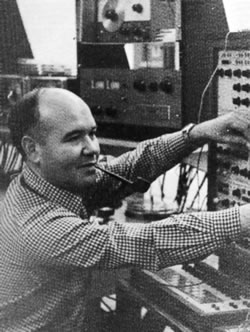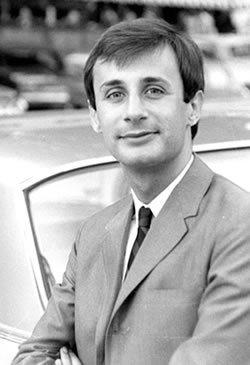Conversations with Alfredo Del Mónaco and Sergio Cervetti, Venezuelan and Uruguayan Composers
In the days before “plug and play”…
This text is based on correspondence with Alfredo Del Mónaco on 22 September 2006 and with Sergio Cervetti on 1 October 2006. Originally published at the EMF Institute.
Among the Latin American composers who worked in the Columbia-Princeton Electronic Music Center during the 1970s were Alfredo Del Mónaco and Sergio Cervetti. Del Mónaco is a composer of orchestral, chamber and electroacoustic music. A pioneer of electronic music in Venezuela, his works have been performed internationally. Del Mónaco completed a Doctor of Musical Arts degree at Columbia University in 1974. Sergio Cervetti, born in Uruguay, moved to New York City in 1970. He worked as an independent composer at Columbia-Princeton through 1977, while teaching at Brooklyn College and subsequently at New York University until his retirement in 2008.
http://www.sergiocervetti.com
Alfredo Del Mónaco
I first became acquainted with the Columbia-Princeton Electronic Music Center when I met Vladimir Ussachevsky and Mario Davidovsky 1[1. Bob Gluck’s “Interview with Mario Davidovsky” is also published in this issue of eContact!] at an International Festival in Caracas, Venezuela, in 1966. We became friendly. Later, they both invited me to come to Columbia at a date of my choosing. I finally came in 1969 as an independent composer. During my stay, I was invited to participate in the relatively new Doctor of Musical Arts program. So, I did. When I first arrived, I had not planned to focus my work on the electronic music studio. But I decided to take advantage of the possibility of working in this renowned studio and so I chose to write my dissertation on the subject. At the time, there were very few theses on electronic music as a doctoral subject; I remember only Charles Dodge’s thesis on computer music.

During my time as an independent composer at Columbia, Vladimir Ussachevsky and Mario Davidovsky both helped me grow enormously in all ways, inside and out. The University’s huge, seemingly endless libraries always kept me reading on all topics that interested me in the Humanities. Also being in New York City for so many years kept me in touch with all the Arts festivals, cinema, dance, concerts and so on, which were of extreme importance for a composer of our time. While at Columbia, I composed eight electronic works, three of them for instruments and tape. In 1974, two of my electronic works were released on recordings and later, several appeared on various labels in Europe, USA and South America.
I ultimately decided not to continue composing electronic music, although I completed one more work in 1992. The seeds for this decision came during my time at Columbia, in 1971–72, when found that most discussions were based on engineering problems. Although these were interesting topics, this is not my field. I wanted to work with something more “settled” so that I could focus more directly on musical issues. I think that I fulfilled all of the needs that led me to work with electronic music. I had sought to improve my knowledge of acoustics and to apply electronic music techniques to my orchestral pieces. Since my experience at Columbia, I’ve approached orchestration from different perspectives than before, such that my instrumental pieces sound like electronics. But in fact, they are not. It also led me to improve the timbral aspects of my composing.
Sergio Cervetti
Before coming to New York, I spent one year in West Berlin as a Composer-in-Residence for the DAAD (Deutscher Akademischer Austauschdienst) Künstlerprogramm, in 1969. alcides lanza 2[2. Bob Gluck’s “Conversation with alcides lanza” is also published in this issue of eContact!] received the same invitation two years later. I gave a few performances there and received a commission from the Akademie der Künste for a ballet in collaboration with Greek painter Alexis Akritakis and American choreographer Ken Rinker. It was performed at the Akademie on 22 June 1969. I unfortunately did not do any work with electronics there.
After that year, I settled in New York City, where I taught counterpoint and harmony at Brooklyn College in 1970 as a part-time faculty member. It was alcides lanza who introduced me to the electronic studio at Columbia. alcides and I come from opposite sides of the Uruguay river — he from Argentina, me from Uruguay — from towns only 90 miles apart. We never met while in South America, but did finally in Washington DC in 1967 during the Inter-American Music Festival organized by Guillermo Espinosa, a very courageous and enterprising man in charge of the Cultural Department of the Organization of American States (OAS). We continued to develop our friendship and we are still in contact with each other, although he lives in Montréal. He was a guest in my house here in Doylestown, in the Spring of 2000. We performed together many times, often joined by Jon Deak and James Fulkerson. I remember specific performances in Montréal and Houston, Texas.

Once I was in New York City in 1970, I proposed to alcides that he teach me electronic music. alcides suggested I came with him to the studio on 116th Street to get some idea of the complexities of composing music with the equipment of that era. I met with him for a few lessons and then I enrolled part-time in order to gain access to the studio. I also studied briefly with Mario Davidovsky and Vladimir Ussachevsky. I remember going to work in that studio every Saturday at 1:30–3:00 p.m. I relished the time when the guy after me didn’t show up (which was often) so I could use his time. And time flew by very fast when in there! Only alcides assisted me at the time. And his assistance was invaluable.
From the vantage point of 2006, my experience during the 1970s at the Columbia-Princeton Electronic Music Center was invaluable. Now with the instant gratification you get from the current technology I find it almost impossible to instil in the younger generation the value of learning the basic elements of electronics… “Plug and play” is the motto these days!
In the fall of 1972, I began teaching part time at the New York University (NYU) School of the Arts (it was not yet called the Tisch School of the Arts). I inherited a very basic electronic studio that [replaced the previous one that] had been put together by Morton Subotnick [then Artist-in-Residence, 1966–69] in 1966. The equipment included a very basic Buchla module and only a 4-track recorder. Morton had left the year before I arrived, tired — I guess — of fighting the stinginess of the NYU Administration.
When I became full-time in 1975, I expanded the studio with more recording devices and a Moog Synthesizer. I created a course in the Theater Program teaching basic synthesis and composing using both concrète technique and electronic synthesis. It was quite successful and attracted quite a lot of students. The studio didn’t have a name and only served theatre and dance students [the disciplines, along with cinema, offered at the school] who wanted to make their own scores. There was no one else at the time teaching anything like this at the School of Arts. Getting money from the NYU administration was like getting blood out of a brick and it took years to make something more than makeshift. Even so, my continuous fight to purchase new and better equipment continued for the next twenty-five years that I taught there. Quite irksome!
Social top